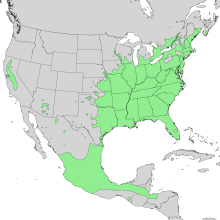Western button bush
| Western button bush | ||||||||||||
|---|---|---|---|---|---|---|---|---|---|---|---|---|

Western button bush ( Cephalanthus occidentalis ) |
||||||||||||
| Systematics | ||||||||||||
|
||||||||||||
| Scientific name | ||||||||||||
| Cephalanthus occidentalis | ||||||||||||
| L. |
The western button bush ( Cephalanthus occidentalis ) is a species of the genus Cephalanthus within the red family (Rubiaceae). It is distributed from North America through Mexico to Central America . Common English names are: buttonbush, common buttonbush, button-willow, honey-bells.
description
Vegetative characteristics
The western button bush grows as a deciduous shrub or small tree , with heights of 1 to 3, rarely up to 6 meters.
Which are arranged opposite or threes in whorls leaves are divided into petiole and leaf blade. The petiole is relatively short. The entire, simple leaf blade is 7 to 18 centimeters long and 4 to 10 centimeters wide and elliptical to ovate.
Generative characteristics
There is an inflorescence stem. Many flowers stand close together in a spherical inflorescence with a diameter of 2.0 to 3.5 centimeters . The hermaphrodite flowers are four-fold with a double flower envelope . Sepals and petals are connected to each other. The white to pale yellow petals are fused into a long, slender corolla tube. The stigma protrudes slightly from the corolla.
The fruit is a spherical structure made of achenes (nuts).
ecology
Water birds and other birds eat the seeds. Wood ducks use the plants to protect their nests . Deer bite the leaves. Insects and hummingbirds suck nectar , which the honeybee uses to make honey .
Occurrence
Cephalanthus occidentalis has a disjoint area in eastern and western North America. In Canada , records are known from southern Ontario and Quebec , which extend eastward to New Brunswick and southwestern Nova Scotia . Except for the eastern United States and the eastern regions of the Midwest, there are significant populated areas in Arizona , the Mogollon Rim, and other mountain ranges, as well as in California throughout the San Joaquin Valley, west of the Great Plains and the Rocky Mountains , of western button bush only in west -Texas, Arizona and California before. Another population is known from Mexico .
In its natural range, the western button bush is a common wood in many wetlands such as quarries , floodplains , mangroves , pocosins , alluvial forests and in the undergrowth of moist forests. It is also part of the flora of the Everglades .
Systematics
The first publication of Cephalanthus occidentalis was made in 1753 by Carl Linnaeus in Species Plantarum , 1, page 95. synonyms for Cephalanthus occidentalis L. are: Cephalanthus acuminatus Raf. , Cephalanthus angustifolius Dippel , Cephalanthus berlandieri Wernham , Cephalanthus hansenii Wernham , Cephalanthus obtusifolius Raf. , Cephalanthus oppositifolius Moench , Cephalanthus pubescens (Raf.) Raf. , Cephalanthus occidentalis subsp. californicus (Benth.) AEMurray , Cephalanthus occidentalis var. brachypodus DC. , Cephalanthus occidentalis var. Californicus Benth. , Cephalanthus occidentalis var. Macrophyllus Raf. , Cephalanthus occidentalis var. Obtusifolius Raf. , Cephalanthus occidentalis var. Pubescens Raf. Subtaxa will no longer be accepted.
use
Bee forage plant
Cephalanthus occidentalis is a good source of nectar ( "bee pasture" ). It is suitable for butterfly gardens.
Ornamental plant
The western button bush is used as an ornamental plant in parks and gardens because of its attractive appearance . It is used in near-natural landscaping because of its support in erosion control .
Medicinal plant
A number of historical medical uses are known for the western button bush . It is a poisonous plant because it contains cephalathin .
Landmark in the San Joaquin Valley
The small town of Buttonwillow (California) was named after the western button bush. A single one of these shrubs once served as a landmark on an old Yokuts Indian trail crossing the San Joaquin Valley as a meeting point. A rodeo area was later set up here by white settlers . The button bush tree is listed as California Historical Landmark No. 492 officially registered and known as the "Buttonwillow Tree".
Individual evidence
- ↑ a b Cephalanthus occidentalis in the Germplasm Resources Information Network (GRIN), USDA , ARS , National Genetic Resources Program. National Germplasm Resources Laboratory, Beltsville, Maryland. Retrieved July 24, 2019.
- ↑ Cephalanthus occidentalis L. buttonbush . In: Wildland Shrubs of the United States and its Territories: Thamnic Descriptions . United States Forest Service. Retrieved September 14, 2009.
- ↑ a b c d Cephalanthus occidentalis . In: Fire Effects Information System = FEIS . United States Forest Service.
- ↑ a b Common Buttonbush Cephalanthus occidentalis L. . In: Natural Resources Conservation Service Plant Guide . United States Department of Agriculture.
- ^ Elbert L. Little: Map 34-NW, Map 34-SW, Cephalanthus occidentalis . In: Minor Western Hardwoods (= Atlas of United States Trees), Volume 3. US Government Printing Office, 1976.
- ^ Cephalanthus occidentalis at Tropicos.org. Missouri Botanical Garden, St. Louis, accessed July 24, 2019.
- ↑ a b c Rafaël Govaerts (Ed.): Cephalanthus occidentalis. In: World Checklist of Selected Plant Families (WCSP) - The Board of Trustees of the Royal Botanic Gardens, Kew . Retrieved July 24, 2019.
- ↑ G. Davidse et al. (eds.): Flora Mesoamericana , Volume 4, 2, Universidad Nacional Autónoma de México, 2012, pp. 1–533. online at Cephalanthus occidentalis at Tropicos.org. In: Flora Mesoamericana . Missouri Botanical Garden, St. Louis
- ↑ Penelope O'Sullivan: The Homeowner's Complete Tree & Shrub Handbook: The Essential Guide to Choosing, Planting, and Maintaining Perfect Landscape Plants . Storey Publishing, 2007, ISBN 978-1-58017-571-5 .
Web links
- Buttonbush Cephalanthus occidentalis . In: Ontario Trees & Shrubs . WILDWOOD CANADA Inc. Accessed July 10, 2019. (English)
- USDA Plants Profile: Cephalanthus occidentalis (English)
- Missouriplants: Cephalanthus occidentalis var. Occidentalis . (English)
- Jepson Flora Project: Cephalanthus occidentalis var. Californicus . (English)
- Photo gallery. (English)


